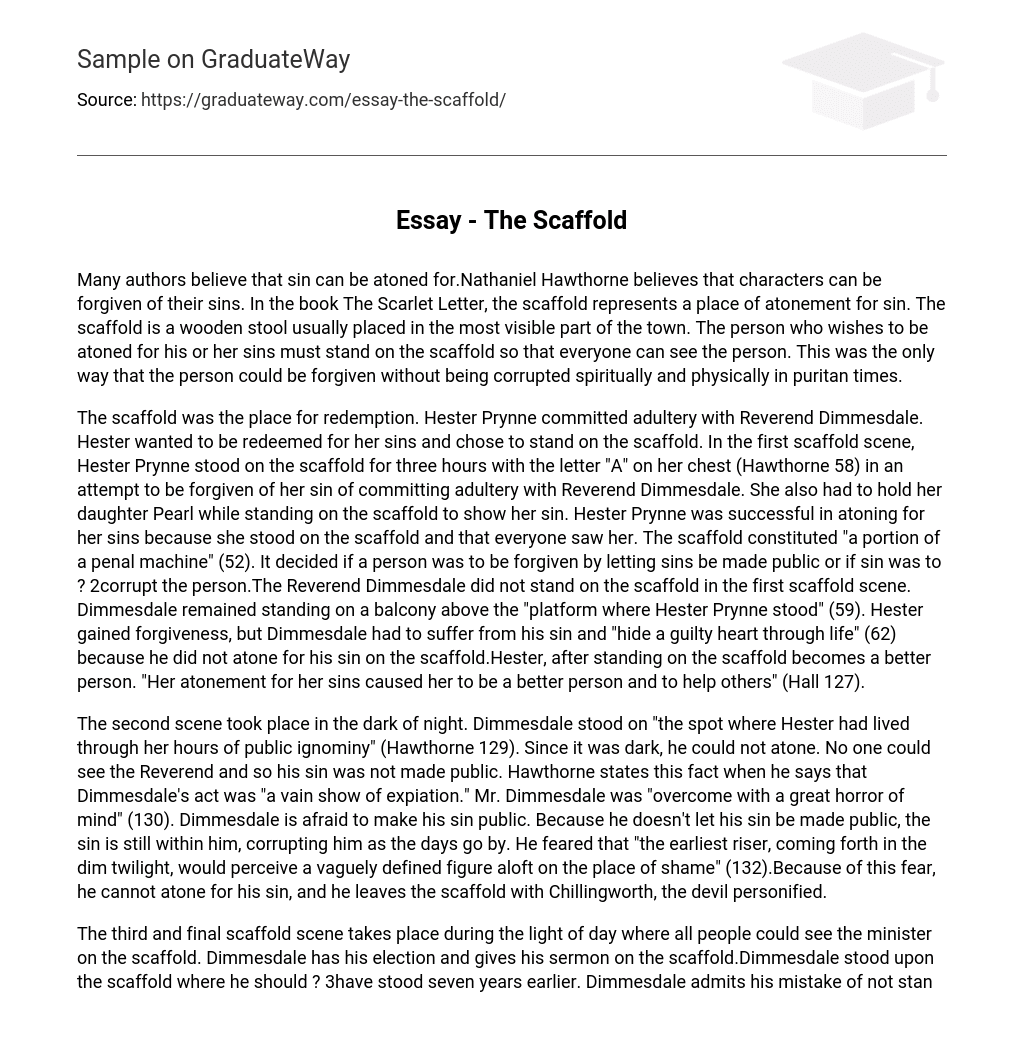Many authors believe that sin can be atoned for.Nathaniel Hawthorne believes that characters can be forgiven of their sins. In the book The Scarlet Letter, the scaffold represents a place of atonement for sin. The scaffold is a wooden stool usually placed in the most visible part of the town. The person who wishes to be atoned for his or her sins must stand on the scaffold so that everyone can see the person. This was the only way that the person could be forgiven without being corrupted spiritually and physically in puritan times.
The scaffold was the place for redemption. Hester Prynne committed adultery with Reverend Dimmesdale. Hester wanted to be redeemed for her sins and chose to stand on the scaffold. In the first scaffold scene, Hester Prynne stood on the scaffold for three hours with the letter “A” on her chest (Hawthorne 58) in an attempt to be forgiven of her sin of committing adultery with Reverend Dimmesdale. She also had to hold her daughter Pearl while standing on the scaffold to show her sin. Hester Prynne was successful in atoning for her sins because she stood on the scaffold and that everyone saw her. The scaffold constituted “a portion of a penal machine” (52). It decided if a person was to be forgiven by letting sins be made public or if sin was to ? 2corrupt the person.The Reverend Dimmesdale did not stand on the scaffold in the first scaffold scene. Dimmesdale remained standing on a balcony above the “platform where Hester Prynne stood” (59). Hester gained forgiveness, but Dimmesdale had to suffer from his sin and “hide a guilty heart through life” (62) because he did not atone for his sin on the scaffold.Hester, after standing on the scaffold becomes a better person. “Her atonement for her sins caused her to be a better person and to help others” (Hall 127).
The second scene took place in the dark of night. Dimmesdale stood on “the spot where Hester had lived through her hours of public ignominy” (Hawthorne 129). Since it was dark, he could not atone. No one could see the Reverend and so his sin was not made public. Hawthorne states this fact when he says that Dimmesdale’s act was “a vain show of expiation.” Mr. Dimmesdale was “overcome with a great horror of mind” (130). Dimmesdale is afraid to make his sin public. Because he doesn’t let his sin be made public, the sin is still within him, corrupting him as the days go by. He feared that “the earliest riser, coming forth in the dim twilight, would perceive a vaguely defined figure aloft on the place of shame” (132).Because of this fear, he cannot atone for his sin, and he leaves the scaffold with Chillingworth, the devil personified.
The third and final scaffold scene takes place during the light of day where all people could see the minister on the scaffold. Dimmesdale has his election and gives his sermon on the scaffold.Dimmesdale stood upon the scaffold where he should ? 3have stood seven years earlier. Dimmesdale admits his mistake of not standing on the scaffold. “I stand upon thee where, seven years since I should have stood” (220). “Everyone sees the minister on the scaffold now” (Waggoner 243). It is in the “clear light of day” (Hall 72). He reveals the “A” on his chest and “Thou has escaped me”(221). Dimmesdale finally gets atonement, but it was too late. He confesses but then dies on the scaffold. For he already suffered from the sin. He was already corrupted. Baym comments on the importance of the scaffold in Nathaniel Hawthorn’s novel. She proves first of all the story was based around three main scaffold scenes in which different characters tried to receive penance for sins (87). The location of the scaffold was also of importance. It was placed where everyone can see it, so that the person standing on it could be pardoned (149). Finally she verifies that the scaffold represents Puritan justice and enforcement of laws (81).
Nathaniel Hawthorne portrays the scaffold as a place of atonement for sin. He creates this idea from the three main scaffold scenes in The Scarlet Letter. In each of the scenes, the outcome was different. Hester was forgiven for her sin, however Roger Dimmesdale was not. He was later forgiven when he stood on the scaffold in public. This shows the importance of making your sins be known publicly. Many critics comment on Hawthorne’s scaffold as a representation for atonement for sin.
? 4Works CitedBaym, Nina. The Scarlet Letter: A Reading. Boston: Twayne, 1986.
Hall, Lawrence Sargent. Hawthorne: Critic of Society. Boston: Yale, 1966.
Hawthorne, Nathaniel. The Scarlet Letter. New York: Penguin, 1986.
Waggoner, Hyatt H. “Nathaniel Hawthorne.” American Writers II. Ed. Leonardo Unger. New York: Scribner, 1974. 223-246





